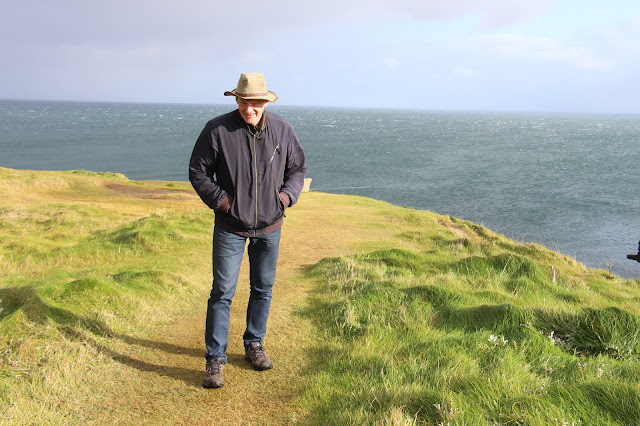We are having a very good experience at Lindisfarne B&B. The bed is super comfy and the big soft chairs and sofas in the common room provide a homey place to sit with our laptops.
After breakfast, we drove to Kirkwall, Orkney’s largest town. There, we saw St. Magnus Cathedral and the Orkney Museum.
The cathedral is dedicated to St. Magnus, a Christian Viking earl who was betrayed and slain in 1117 by his cousin, who wanted to replace him as Earl of Orkney. Magnus’s nephew came from Norway in 1129, took back the earldom, and had the cathedral built in his honour. That’s making a very, very long story short. The cathedral is beautiful inside and out, built of red and yellow sandstone that gives it a soft, distinctive look. Magnus’s bones are still buried there.
Next, we drove to the Tomb of the Eagles, on the island of South Ronaldsay. Either we hadn’t noticed, or the guide book didn’t say…but it apparently closes at 12:30, so we missed it. (Fred was especially disappointed, as he wanted to see Glen Frey’s grave, ha ha).
Right beside the closed visitor centre was a field with Jacob sheep, which we had only ever seen on TV. They are strange creatures — piebald and four-horned!
And the trip to South Ronaldsay was beautiful, driving along the Churchill Barriers — four causeways that link the islands of Mainland, Lamb Holm, Glims Holm, Burray, and South Ronaldsay. Waves crashing against the causeways sent spray over the road in several places.
The wind is incredibly strong on the islands. You have to lean into it when you walk, or you’ll be blown over. The many wind turbines that dot the landscape are whirling; the smaller ones whirl at a pace that renders their blades a near-invisible blur.
On our way back, we paused on Lamb Holm to see the Italian Chapel, which was built by the Italian prisoners of war who lived at Camp 60 on the island. Camp 60 housed 300 PoWs, and two other camps on Burray housed 700. These 1300 men provided most of the labour needed to build the Churchill Barriers.
The chapel is beautiful, and the men constructed every bit of it from whatever they had on hand. Wood from a shipwreck, for example, became the altar. A statue of St. George was made from barbed wire and concrete. The genius POW behind the art was Domenico Chiocchetti, who actually stayed on after the war, to complete the font. He returned for three weeks in 1960 to lovingly restore the interior. A service was held on his last Sunday in Orkney, and he was the first to receive communion.
From Lamb Holm, we drove to The Gloup, on the east coast of Mainland. The Gloup is a collapsed sea cave in the Mull Head Nature Reserve. The name derives from the Old Norse "gluppa", meaning a chasm. The cave is separated from the sea by a land bridge about 80 metres wide. It is about 40 metres long and 25 metres deep.
Back to Kirkwall for tea and cake, then back to our B&B. We were thoroughly chilled from all that cold wind, so we nipped out for hearty beef stew at a restaurant in Stromness. Feeling much better now!
 |
| Fred steadies himself against the strong wind. That's the North Sea behind him! |







No comments:
Post a Comment